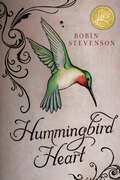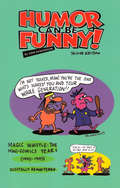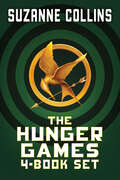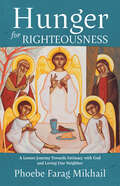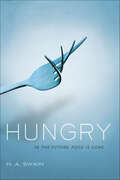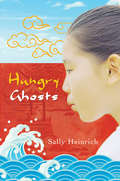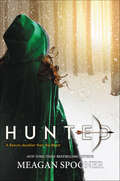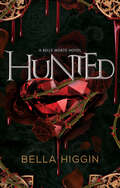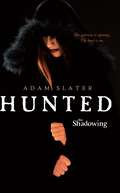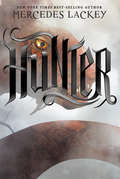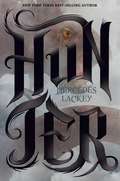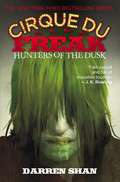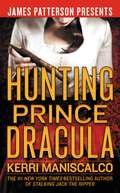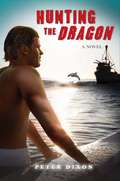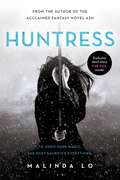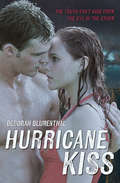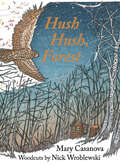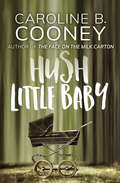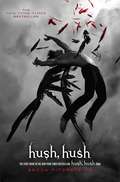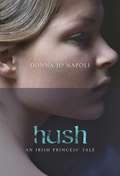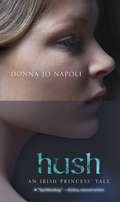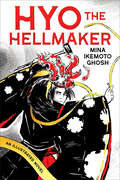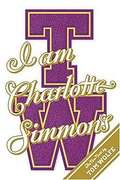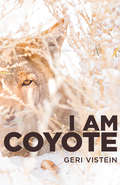- Table View
- List View
Hummingbird Heart
by Robin StevensonSixteen-year-old Dylan has never met her father. She knows that her parents were just teenagers themselves when she was born, but her mother doesn't like to talk about the past, and her father, Mark, has never responded to Dylan's attempts to contact him. As far as Dylan is concerned, her family is made up of her mother, Amanda; her recently adopted younger sister, Karma; and maybe even her best friend, Toni. And then, out of the blue, a phone call: Mark will be in town for a few days and he wants to meet her. Amanda is clearly upset, but Dylan can't help being excited at the possibility of finally getting to know her father. But when she finds out why he has come—and what he wants from her—the answers fill her with still more questions. What makes someone family? And why has her mother been lying to her all these years?
Humor Can Be Funny
by Sam HendersonSam Henderson's early minicomics and self-published Magic Whistle comic all collected under one cover. <P><P>Henderson's drawing is intentionally crude, but it has the same kind of energy you see in the work of today's best gag cartoonists, whose drawing also tends to be a little basic. Extremely low-brow humor that almost parodies low-brow humor - it's enjoyable on either level.
Hunger Games 4-Book Digital Collection (The Hunger Games)
by Suzanne CollinsIn the ruins of a place once known as North America lies the nation of Panem, a shining Capitol surrounded by twelve outlying districts. The Capitol keeps the districts in line by forcing them all to send one boy and one girl between the ages of twelve and eighteen to participate in the annual Hunger Games, a fight to the death on live TV...And the odds are against all who play.With all four of Suzanne Collins's Hunger Games novels in one digital collection, you can step into the world of Panem with the 10th annual Hunger Games, and continue all the way to the electrifying conclusion.
Hunger for Righteousness: A Lenten Journey Towards Intimacy with God and Loving Our Neighbor
by Phoebe Farag Mikhail"Blessed are those who hunger and thirst for righteousness, for they will be filled." Matthew 5:6 How do we hunger for righteousness? Readers are given a fresh opportunity to reconsider the words of scripture and liturgy from a modern perspective as they explore the familiar traditions and practices of Lent, Holy Week, and Easter. Farag Mikhail presents stories of modern and ancient Christian heroes – some familiar, others less well-known – who come alive in a contemporary and relatable way, as readers prepare for, and participate in the spiritual practices of Lent. With surprising and challenging reflections, familiar concepts of almsgiving, prayer, fasting, repentance, reading of Scripture, forgiveness, and pilgrimage are given fresh insight. Questions at the end of each chapter prompt thoughtful actions to enhance the Lenten journey and invite the reader to draw closer to God and share the love of Christ with their neighbors. Readers searching for a lively and invigorating way to rededicate themselves to the spiritual journey of Lent, are treated to a captivating blend of biblical truths and cultural context. Farag Mikhail offers historical and theological insights to apply to our everyday lives as we prepare our hearts to celebrate the Resurrection. If we pay closer attention to the earliest Christian Lenten traditions, we'll discover how Lent was a period during which individuals who wanted to become Christian prepared themselves not for personal transformation, but to join the body of believers, the communion of saints, through baptism. By examining our liturgical prayers and Scripture readings developed over centuries, we'll discover the ways Lent has always been a time for individual repentance, yes, but first for giving and forgiving, for mending relationships and building new ones, for fighting injustice, and for growing in intimacy with God communally, not just individually. —Introduction, Hunger for Righteousness
Hungry
by H. A. SwainFor fans of The Giver, a futuristic thriller with a diverse cast. In Thalia's world, there is no more food and no need for food, as everyone takes medication to ward off hunger. Her parents both work for the company that developed the drugs society consumes to quell any food cravings, and they live a life of privilege as a result. When Thalia meets a boy who is part of an underground movement to bring food back, she realizes that there is an entire world outside her own. She also starts to feel hunger, and so does the boy. Are the meds no longer working? Together, they set out to find the only thing that will quell their hunger: real food. It's a journey that will change everything Thalia thought she knew. But can a "privy" like her ever truly be part of a revolution?
Hungry Ghosts
by Sally HeinrichSarah hadn?t wanted to come to Australia. She?s been perfectly happy with things how they were in Singapore where school was for learning, and `being cool? was a non-issue. Now Dad was trying his best to make her into a `fair dinkum? Aussie while Mum was determined to hang on to all the old Asian traditions. During the Festival of the Hungry Ghosts Sarah meets the ghost of Pei, a Chinese girl who was not much older than Sarah when she died. As the story unfolds, it becomes apparent that the girls share a common ancestry. Initially reluctant, Sarah helps Pei to discover the truth about events surrounding her death and the lover she believed had betrayed her. Set in contemporary Singapore and Australia, and nineteenth-century China and Australia, this sprawling tale by Sally Heinrich touches on issues of Chinese immigration to Australia from the 1800s to the present.
Hunted
by Meagan SpoonerNew York Times bestselling author Meagan Spooner spins a thoroughly thrilling Beauty and the Beast story for the modern age, expertly woven with spellbinding romance, intrigue, and suspense that readers won’t soon be able to forget.Beauty knows the Beast's forest in her bones—and in her blood. After all, her father is the only hunter who’s ever come close to discovering its secrets.So when her father loses his fortune and moves Yeva and her sisters out of their comfortable home among the aristocracy and back to the outskirts of town, Yeva is secretly relieved. Out in the wilderness, there’s no pressure to make idle chatter with vapid baronessas…or to submit to marrying a wealthy gentleman.But Yeva’s father’s misfortune may have cost him his mind, and when he goes missing in the woods, Yeva sets her sights on one prey: the creature he’d been obsessively tracking just before his disappearance. The Beast.Deaf to her sisters’ protests, Yeva hunts this strange creature back into his own territory—a cursed valley, a ruined castle, and a world of magical creatures that Yeva’s only heard about in fairy tales. A world that can bring her ruin, or salvation. Who will survive: the Beauty, or the Beast?
Hunted (Belle Morte Ser. #3)
by Bella HigginIn the third installment of the Belle Morte series, follow vampire Ludovic and human Roux who are on the hunt to bring renegade vampires to justice while denying the complicated feelings for one another.With the help of Renie and Edmond, the battle for Belle Morte has been fought and won. However, the bigger fight is not over, as enemy vampires have escaped into the city and the future of vampirekind hangs in the balance. The escapees must be brought to justice - and fast.For fellow Belle Morte celebrity, the reclusive vampire Ludovic de Vauban, this is the perfect opportunity to confront his fears about the world beyond the mansion's walls. But he can't do this alone. Enter donor Roux Hayes;. accomplished liar, quick thinker, and street savvy human. She can help Ludovic navigate a world that has long since left him behind.As the unlikely duo work together to preserve a future for their friends, they discover a mutual passion that neither of them expected, one that burns hotter than anything either of them have ever experienced. But the shadow of old enemies stretches longer than they ever imagined and threatens not only every one they love, but also the new love they have found in each other.
Hunted (The Shadowing #1)
by Adam SlaterOnce every century, the barrier between the human world and the demon realm begins to break down. Creatures gather, anxiously waiting to cross the divide, to bring death and destruction from their world to ours. This time is called The Shadowing. Callum Scott has always known that there is a supernatural world out there—he's seen ghosts for as long as he can remember. Lately, he's had visions of children being brutally murdered by a terrifying creature. Then the visions start coming true, and Callum realizes that he's being hunted, too. Driven by a dark destiny, he must stand against the demons that threaten our world. And The Shadowing is almost here. . .
Hunter (A Hunter Novel #1)
by Mercedes LackeyThey came after the Diseray. Some were terrors ripped from our collective imaginations, remnants of every mythology across the world. And some were like nothing anyone had ever dreamed up, even in their worst nightmares. Monsters. Long ago, the barriers between our world and the Otherworld were ripped open, and it's taken centuries to bring back civilization in the wake of the catastrophe. Now, the luckiest Cits live in enclosed communities, behind walls that keep them safe from the hideous creatures fighting to break through. Others are not so lucky. To Joyeaux Charmand, who has been a Hunter in her tight-knit mountain community since she was a child, every Cit without magic deserves her protection from dangerous Othersiders. Then she is called to Apex City, where the best Hunters are kept to protect the most important people. Joy soon realizes that the city's powerful leaders care more about luring Cits into a false sense of security than protecting them. More and more monsters are getting through the barriers, and the close calls are becoming too frequent to ignore. Yet the Cits have no sense of how much danger they're in-to them, Joy and her corp of fellow Hunters are just action stars they watch on TV. When an act of sabotage against Joy takes an unbearable toll, Joy uncovers a terrifying conspiracy in the city. There is something much worse than the usual monsters infiltrating Apex. And it may be too late to stop them?
Hunter (Hunter Ser.)
by Mercedes LackeyThey came after the Diseray. Some were terrors ripped from our collective imaginations, remnants of every mythology across the world. And some were like nothing anyone had ever dreamed up, even in their worst nightmares. <P><P>Monsters. <P><P>Long ago, the barriers between our world and the Otherworld were ripped open, and it's taken centuries to bring back civilization in the wake of the catastrophe. Now, the luckiest Cits live in enclosed communities,behind walls that keep them safe from the hideous creatures fighting to break through. Others are not so lucky. <P><P>To Joyeaux Charmand, who has been a Hunter in her tight-knit mountain community since she was a child, every Cit without magic deserves her protection from dangerous Othersiders. Then she is called to Apex City, where the best Hunters are kept to protect the most important people. <P><P>Joy soon realizes that the city's powerful leaders care more about luring Cits into a false sense of security than protecting them. More and more monsters are getting through the barriers,and the close calls are becoming too frequent to ignore. Yet the Cits have no sense of how much danger they're in-to them, Joy and her corp of fellow Hunters are just action stars they watch on TV. <P><P>When an act of sabotage against Joy takes an unbearable toll, Joy uncovers a terrifying conspiracy in the city. There is something much worse than the usual monsters infiltrating Apex. And it may be too late to stop them?
Hunters of the Dusk: The Saga of Darren Shan #7) (Cirque Du Freak #7)
by Darren ShanThe pursuit begins ... Darren Shan, the Vampire Prince, leaves Vampire Mountain on a life-or-death mission. As part of an elite force, Darren searches for the Vampaneze Lord. But the road ahead is long and dangerous, and lined with the bodies of the damned.
Hunting Prince Dracula (Stalking Jack the Ripper #2)
by Kerri ManiscalcoIn this New York Times bestselling sequel to Kerri Maniscalco's haunting #1 debut Stalking Jack the Ripper, bizarre murders are discovered in the castle of Prince Vlad the Impaler, otherwise known as Dracula. Could it be a copycat killer . . . or has the depraved prince been brought back to life? Following the grief and horror of her discovery of Jack the Ripper's true identity, Audrey Rose Wadsworth has no choice but to flee London and its memories. Together with the arrogant yet charming Thomas Cresswell, she journeys to the dark heart of Romania, home to one of Europe's best schools of forensic medicine . . . and to another notorious killer, Vlad the Impaler, whose thirst for blood became legend. But her life's dream is soon tainted by blood-soaked discoveries in the halls of the school's forbidding castle, and Audrey Rose is compelled to investigate the strangely familiar murders. What she finds brings all her terrifying fears to life once again.
Hunting the Dragon
by Peter DixonBilly Crawford is a blond, eighteen-year-old surfer from Southern California, working in Fiji as a surfing instructor. But when he gets fired for leading his students into some dangerous surf, his endless summer seems to be over, and he decides that it's time to get a real job. He comes across a tuna clipper called Lucky Dragon whose crew is short a boatman, and the first mate offers him a job. What Billy doesn't know is that the clipper finds tuna by following dolphins. When Lucky Dragon sets its net for the first time, Billy witnesses a harrowing sight???dolphins being killed by the Dragon's money-hungry pirates. When he attempts to save a dolphin who is caught in the tuna net, the Dragon's captain tosses Billy and his belongings???including his surfboard???into the ocean and leaves.
Huntress
by Malinda LoNature is out of balance in the human world. The sun hasn't shone in years, and crops are failing. Worse yet, strange and hostile creatures have begun to appear. The people's survival hangs in the balance.To solve the crisis, the oracle stones are cast, and Kaede and Taisin, two seventeen-year-old girls, are picked to go on a dangerous and unheard-of journey to Tanlili, the city of the Fairy Queen. Taisin is a sage, thrumming with magic, and Kaede is of the earth, without a speck of the otherworldly. And yet the two girls' destinies are drawn together during the mission. As members of their party succumb to unearthly attacks and fairy tricks, the two come to rely on each other and even begin to fall in love. But the Kingdom needs only one huntress to save it, and what it takes could tear Kaede and Taisin apart forever.The exciting adventure prequel to Malinda Lo's highly acclaimed novel Ash is overflowing with lush Chinese influences and details inspired by the I Ching, and is filled with action and romance.
Hurricane Kiss
by Deborah BlumenthalFor sixteen-year-old Jillian McKay, the threat of Hurricane Danielle means a long car ride with her neighbors--including River Daughtry. Yes, that River Daughtry--the former star quarterback of Harrison High. The guy who was headed to glory until suddenly he disappeared to a West Texas juvenile detention center. The guy she kissed. But he's a mystery to everyone: once cocky and flirtatious, he's now silent and angry, a dropout who avoids everyone. When their evacuation route is stuck in a massive gridlock, however, River is the first to recognize the danger they're in. Together he and Jillian set out to seek shelter in their abandoned high school. As the weather intensifies, Jillian sees a storm is building inside River as well, and in the dark hallways of the school, they realize survival is about more than just staying alive--it's about fighting for yourself.
Hurricane Reef
by Bryce WaltonWhile visiting his uncle and cousin on a Caribbean island, Steve spends the summer performing science projects and collecting data that will help him win a Science scholarship to study oceanography at the U.S. Government Marine Science Institute at the University of Miami. Surviving a hurricane gives him a new outlook on life.
Hush Hush, Forest
by Mary CasanovaLyrical words and elegant woodcuts capture the quiet beauty of the forest as day fades to night and autumn gives way to the North Woods winter While we are tucked in, snug in warm blankets as we listen to bedtime stories, the woods around us whisper another tale. As the golden leaves waft through the lengthening shadows, the loon sings one last lullaby, the whirring hummingbird takes one last sip, the industrious beaver saws one last branch for her lodge. Here, in enchanting words and woodcuts, is the magic of night falling and winter approaching in the North Woods. Hush Hush, Forest peers through twilight&’s window at the raccoon preening, the doe and fawn bedding down, the last bat of the season flitting away. The owl surveys, the rabbit scurries, the bear hunkers, readying her den.Marking the rhythm between the falling leaf and the falling snowflake, picturing the rituals of creatures big and small as they prepare for the long winter&’s sleep, this charming book captures a time of surpassing wonder for readers of all ages—and bids everyone in the hushed forest a peaceful good night.
Hush Little Baby
by Caroline B. CooneyA teenager risks everything to protect an abandoned baby in this thriller from the bestselling author of The Face on the Milk Carton. When Kit Innes&’s frazzled ex-stepmother, Dusty, leaves her with an unnamed baby boy and a lot of questions, she&’s not sure what to do. She&’s doesn&’t know if the adorable child is even Dusty&’s, or if she plans on returning. But when an angry, frightening man comes looking for the baby, Kit decides that the most important thing is to keep him safe—at all costs. With the help of her maybe-boyfriend, Rowen, and his little sister, Muffin, Kit is determined to figure out what&’s really going on. But as they attempt to return the mysterious baby to wherever it is he belongs, they discover that he&’s part of something that could put them all in incredible danger . . . Filled with mystery and suspense, this riveting story proves why multimillion-copy bestselling author Caroline B. Cooney is a &“thriller master&” (Publishers Weekly). This ebook features an illustrated biography of Caroline B. Cooney including rare images and never-before-seen documents from the author&’s personal collection.
Hush, Hush: The Complete Collection (The Hush, Hush Saga #1)
by Becca FitzpatrickNora finds forbidden love with her fallen angel, in the first book in the New York Times bestselling Hush, Hush saga.For Nora Grey, romance was not part of the plan. She's never been particularly attracted to the boys at her school, no matter how much her best friend, Vee, pushes them at her. Not until Patch came along. With his easy smile and eyes that seem to see inside her, Nora is drawn to him against her better judgment. But after a series of terrifying encounters, Nora's not sure who to trust. Patch seems to be everywhere she is, and to know more about her than her closest friends. She can't decide whether she should fall into his arms or run and hide. And when she tries to seek some answers, she finds herself near a truth that is way more unsettling than anything Patch makes her feel. For Nora is right in the middle of an ancient battle between the immortal and those that have fallen - and, when it comes to choosing sides, the wrong choice will cost her life.
Hush: An Irish Princess' Tale
by Donna Jo NapoliMelkorka is a princess, the first daughter of a magnificent kingdom in mediæval Ireland -- but all of this is lost the day she is kidnapped and taken aboard a marauding slave ship. Thrown into a world that she has never known, alongside people that her former country's laws regarded as less than human, Melkorka is forced to learn quickly how to survive. Taking a vow of silence, however, she finds herself an object of fascination to her captors and masters, and soon realizes that any power, no matter how little, can make a difference. <P><P> Based on an ancient Icelandic saga, award-winning author Donna Jo Napoli has crafted a heartbreaking story of a young girl who must learn to forget all that she knows and carve out a place for herself in a new world -- all without speaking a word.
Hush: An Irish Princess' Tale
by Donna Jo NapoliMelkorka is a princess, the first daughter of a magnificent kingdom in mediæval Ireland -- but all of this is lost the day she is kidnapped and taken aboard a marauding slave ship. Thrown into a world that she has never known, alongside people that her former country's laws regarded as less than human, Melkorka is forced to learn quickly how to survive. Taking a vow of silence, however, she finds herself an object of fascination to her captors and masters, and soon realizes that any power, no matter how little, can make a difference. Based on an ancient Icelandic saga, award-winning author Donna Jo Napoli has crafted a heartbreaking story of a young girl who must learn to forget all that she knows and carve out a place for herself in a new world -- all without speaking a word.
Hyo the Hellmaker
by Mina Ikemoto GhoshFrom debut author Mina Ikemoto Ghosh comes a stunningly illustrated, high-fantasy debut novel. Meet the Hakai Family Hellmakers: Purveyors of artisan hells and unlucky days to inflict on your enemies. They'll make it personal... for a price!Hyo Hakai is a hellmaker, hired to create customized hells and unlucky days for your worst enemies.When a demon destroys her village, Hyo and her brother flee to Onogoro — an island where the gods of their land live among humans. The hellmakers' hereditary curse, however, won't allow Hyo to settle in quietly.Hyo is curse-bound to investigate the deaths that come her way and avenge them. As she's pulled deeper into a tangled web of dark secrets, Hyo must navigate the intricate rules of Onogoro's gods without becoming their pawn. She'll quickly realize that murderers and gods have one thing in common — they always think they can get away with it . . .At least, that was before Hyo arrived.In this breathtaking debut, author and illustrator Mina Ikemoto Ghosh weaves action, fantasy, and myth into an unforgettable illustrated murder-mystery novel.
I Am Charlotte Simmons
by Tom Wolfe<p><p>DUPONT UNIVERSITY-the Olympian halls of learning housing the cream of America's youth, the roseate Gothic spires and manicured lawns suffused with tradition... <p>Or so it appears to beautiful, brilliant Charlotte Simmons, a wide-eyed, bookish freshman from a strict, devout, poor and poorly educated family in the Blue Ridge Mountains of North Carolina. <p>But Charlotte soon learns, to her mounting dismay, that for the upper-crust coeds of Dupont, sex, Cool, and kegs trump her towering academic ambitions every time. <p>As Charlotte encounters the paragons of Dupont's privileged elite - her roommate, Beverly, a Groton-educated Brahmin in lusty pursuit of lacrosse players; Jojo Johanssen, the only white starting player on Dupont's godlike basketball team, whose position is threatened by a hotshot black freshman from the projects; the Young Turk of Saint Ray fraternity, Hoyt Thorpe, whose sense of entitlement and social domination is clinched by his accidental brawl with a bodyguard for the governor of California; and Adam Gellin, one of the Millennial Mutants who run the university's "independent" newspaper and who consider themselves the last bastion of intellectual endeavor on the sex-crazed, jock-obsessed campus -she is seduced by the heady glamour of acceptance, betraying her values and upbringing before she grasps the power of being different and the exotic allure of her innocence. <p>With his celebrated eye for telling detail, Tom Wolfe draws on extensive observation of campuses across the country to immortalize college life in the '00s. I Am Charlotte Simmons is the latest triumph of America's master social novelist, our spot-on chronicler of the way we live now.
I Am Coyote
by Geri VisteinCoyote is three years old when she leaves her family in Algonquin Provincial Park in Ontario and embarks on a 500-mile odyssey eastward in search of a territory of her own and a mate to share it with. Journeying by night through the dead of winter, she endures extreme cold, hunger, and a harrowing crossing of the St. Lawrence River in Montreal before her cries of loneliness are finally answered in the wilds of Maine. The mate she finds must gnaw off a paw to escape a trap. The first coyotes in the northern U.S., they raise pups (losing several), experience summer plenty, winter hardship, playfulness, and unmistakable love and grief. Blending science and imagination with magical results, this story tells how coyotes may have populated a land desperately in need of a keystone predator, and no one who reads it will doubt the value of their ecological role. Told through the eyes of a coyote, this is a riveting story with mythic dimensions. A work of creative nonfiction that adheres to the highest standards of wildlife biology. With deep insights into wild canine behavior, penetrates the veil of "otherness" that separates us from the animals with whom we share the planet. An appendix explores the history and current status of coyotes in North America. Native Americans considered them tricksters, messengers, and companions. Given the disappearance of wolves, they are even more critical to ecosystem health today. The author explains how, without coyotes, prey species are weakened by disease and parasites. Geri Vistein speaks extensively about coyote-human interactions to a variety of audiences. She is a nationally recognized expert on the topic and maintains the website CoyoteLivesInMaine.com. A QR code in the book takes readers to a hauntingly beautiful recording of coyote song.
